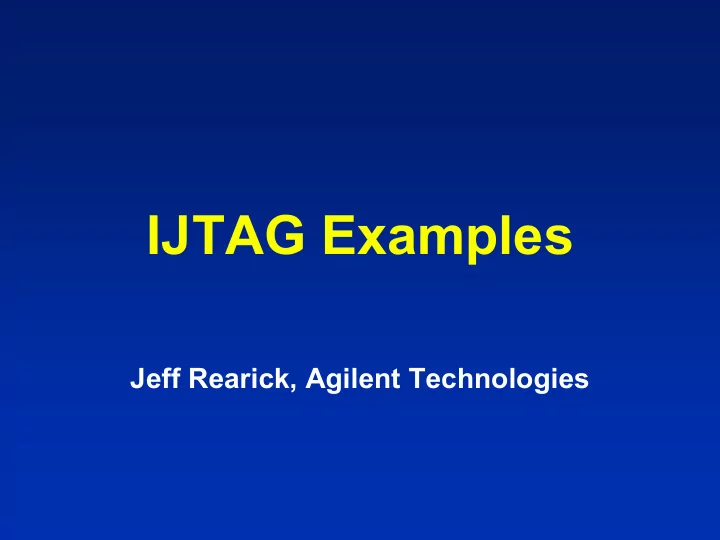

IJTAG Examples Jeff Rearick, Agilent Technologies
IJTAG Scope • This standardization effort is intended to address the access to on-chip instrumentation, not the instruments themselves. The elements of standardized access include: – a description language for the characteristics of the instruments, – a protocol language for communication with the instruments, and – interface methods to the instruments.
TAP-based Access to Test Features ATE, system, uP/ASIC/ASSP/FPGA Desc remote Standard Lang Protocol IEEE Internal test Scan 1149.1 hand features chains TAP shake (BIST, DIAGs, instruments, Latest High etc.) Internal Protocol Test band interface Data width
IJTAG Example Instruments MEMBIST packet_count_regs SerDes PRBS BIST Rx_eye
IJTAG Instrument Description MEMBIST
IJTAG Instrument Description MEMBIST_1 { MEMBIST type = “memory BIST”; launch_proc = MEMBIST_1_launch; check_proc = MEMBIST_1_check; test_options = (stop_on_fail, background, march_alg); } MEMBIST_2 { type = “memory BIST”; launch_proc = MEMBIST_2_launch; check_proc = MEMBIST_2_check; test_options = (stop_on_fail, background, march_alg); }
IJTAG Protocol MEMBIST MEMBIST_1_launch (stop_on_fail, background, march_alg); IR[$_M1stop_on_fail] = $stop_on_fail; if ($background == A) { IR[$M1_background_A] = 1; } elsif ($background == C) { IR[$M1_background_C = 1; } else { error(“bad background”) … }
IEEE 1532 Example : Flow attribute ISC_FLOW of xcf01s_vo20 : entity is "flow_program(array) " & "initialize " & "(DATA0 2048:? wait TCK 1)" & "(FADDR 16:$addr=0 wait TCK 1)" & "(FPGM wait 14.0e-3)" & "Repeat 511 " & "(DATA0 2048:? wait TCK 1)" & "(FADDR 16:$addr+32 wait TCK 1)" & "(FPGM wait 14.0e-3)" & "Terminate " & "(FADDR 16:0001 wait TCK 1)" & "(SERASE wait 37.0e-3)," & "flow_verify(array) " & "initialize " & "(FADDR 16:$addr=0 wait TCK 1)" & "(FVFY0 wait 50.0e-6 2048:$data?:CRC)" & "Repeat 511 " & "(FADDR 16:$addr+32 wait TCK 1)" & "(FVFY0 wait 50.0e-6 2048:$data?:CRC),"
IEEE 1532 Example : Procedure attribute ISC_PROCEDURE of xcf01s_vo20 : entity is "proc_verify(idcode) = (flow_verify(idcode))," & "proc_enable = (flow_enable)," & "proc_disable = (flow_disable)," & "proc_erase = (flow_erase)," & "proc_program = (flow_program(array))," & "proc_verify = (flow_verify(array))," & "proc_verify(usercode) = (flow_verify(usercode))," & "proc_read = (flow_read(array))," & "proc_read(idcode) = (flow_read(idcode))," & "proc_read(usercode) = (flow_read(usercode))," & "proc_program_done = (flow_program_done)," & "proc_error_exit = (flow_error_exit)";
IEEE 1532 Example : Action attribute ISC_ACTION of xcf01s_vo20 : entity is "erase = (proc_verify(idcode) recommended," & " proc_enable," & " proc_erase," & " proc_disable)," & "program = (proc_verify(idcode) recommended," & " proc_enable," & " proc_erase," & " proc_program," & " proc_enable," & " proc_verify optional," & " proc_disable)," &
TAP Access to Chip Test Features BSR Interface BIST SRAM B Wrapped S core MEMBIST Scan chain R B SerDes BERT S LBIST R SerDes BERT Core logic CNTL SerDes BERT SerDes BERT Scan chain SBUS TDR TAP Interface BIST BSR
IJTAG Instrument Description SerDes BIST
IJTAG Protocol SerDes BIST PRBS_1_sel_PRBS7; PRBS_1_pre_emph 0110; PRBS_1_rx_eq_filter 01110100; PRBS_1_tx_start; PRBS_1_rx_check; PRBS_1_rx_eq_tune; PRBS_1_eye_map;
Next Steps • Understand what we need to describe – Descriptions – Protocols • Understand language options – BSDL – STIL – STAPL – … • Select a language • Specify the syntax and semantics
Homework Assignment • Describe your favorite test feature • Focus on procedural access • Email to: • kepos@comcast.net
Recommend
More recommend